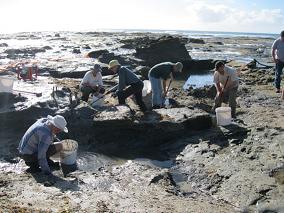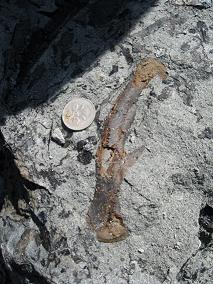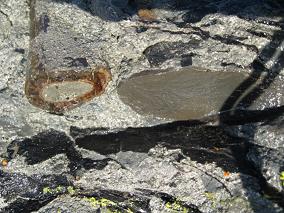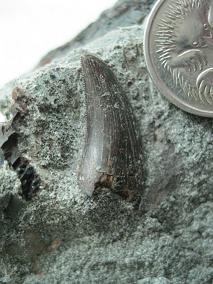Field Update 2012
In February 2012 the Dinosaur Dreaming crew conducted the 19th field season at the Flat Rocks locality, near Inverloch. Over 40 volunteers attended the three week dig, including Jodi Salmond, who flew down from Queensland to take part.
The main aim of the 2012 field season was to excavate a small promontory of fossil bearing rock (the Bridge), which separated the two main parts of the Flat Rocks site (Main and Bridge East). The reason this part of the fossil layer had remained intact for so long was purely practical. It acted as a barrier, preventing the sand covering Main from creeping down into Bridge East. However, it became apparent at the end of the 2011 field season that the Bridge was hampering the excavation of the fossil layer at the western end of Bridge East and so the decision was made to remove it.
 Digging the bridge at Dinosaur Dreaming Inverloch  Digging more of the bridge.  The bridge is removed. Removal of the Bridge went smoothly and numerous fossils were recovered in the process, including a beautifully preserved small ornithopod dinosaur thigh bone (femur). The rock split mostly down the side the bone, breaking only a small area at the top and bottom of the limb bone and exposing its complete length. The small plant-eating dinosaur that this bone belonged to was probably about one metre long.
 A small ornithopod dinosaur femur.
Larger limb bones were also found, including one limb bone that self-prepared itself from the rock. It was found in the uppermost part of the fossil layer, which is more weathered than lower down, and as the rock was split, the bone fell out. I wish they all prepared themselves like that.
 A hollow dinosaur limb bone.
A few fragile bones were also recovered, including a dinosaur fibula, one of the bones in the lower leg. This bone is very thin and gracile and yet was well-preserved in the fossil layer.
 A fragile dinosaur fibula.
A number of dinosaur teeth were also found, including one of the largest theropod teeth yet found at the site. This tooth may well have come from a meat-eating dinosaur similar to Australovenator wintonensis. A partial skeleton of this dinosaur has been found near Winton in Queensland and comparison between its bones and those found in the Victorian Early Cretaceous rocks indicates that a close relative of Australovenator roamed this area too.
 A theropod dinosaur tooth.
Preparation of the Bridge each day is time consuming as the water, which has accumulated during the previous high tide, must be pumped out and any sand carried in by the high tide has to be removed. This can take up to 90 minutes to accomplish, so occasionally rock was removed from an area at the far western end of the fossil layer, closest to the cliff, which is often exposed. This rock is part of the same fossil layer as the Bridge and Bridge East, but is made up of a finer conglomerate and does not yield as many bones. This field season it did produce one of the most exciting finds – a tiny mammal jaw. These jaws typically measure 10-15mms in length and can really only be identified with a magnifying lens.
Since the first mammal jaw was found in 1997 more than 40 mammal jaws have been recovered from the Flat Rocks site. Even though we now have quite a few specimens, they still create enormous excitement when they are found.
At the end of March 2012 Museum Victoria’s Collection manager David Pickering led an expedition to Cape Otway, south west of Melbourne. He and more than 20 volunteers excavated a site called Eric the Red West, which was discovered by Mike Cleeland in 2005. Mike found a partial ornithopod dinosaur skeleton at this site and during subsequent visits a mammal jaw and the first mammal upper jaw fragment were found here. The fossil layer is not a rich as the Flat Rocks site, but it is quite extensive, stretching for many metres along the rocky shore platform. This field season yielded more than 70 fossils, which were taken back to Museum Victoria to be assessed. More than 300 fossil bones and teeth were catalogued during the Inverloch fieldtrip, so the Museum Palaeontology lab is going to be very busy for the next few months.
|